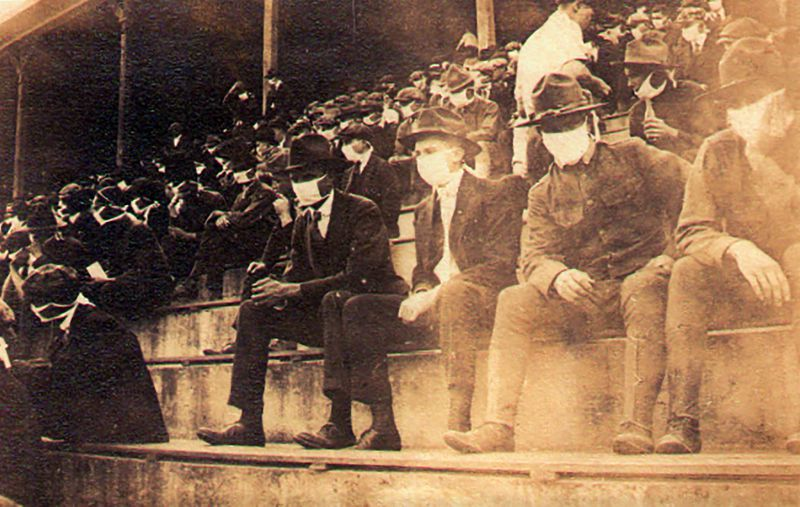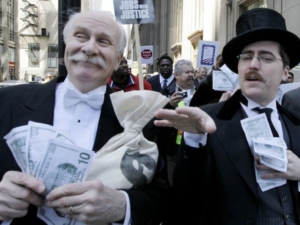Half a dozen little 2021 predictions about life after COVID-19
 Six hundred and seventy-five thousand Americans died of the Spanish Flu in 1918, back when the total population of the United States was 103 million. In the current pandemic, American deaths are already above 540,000 (remember when a projection of 160,000 deaths seemed crazy?) but our population is now 331 million. While COVID-19 will undoubtedly kill more Americans than did the Spanish flu, the percentage of the population dying will be much lower than the 0.65 percent death rate in 1918. But the numbers are close enough that one might guess the long-term impact of this pandemic could be very similar to that one.
Six hundred and seventy-five thousand Americans died of the Spanish Flu in 1918, back when the total population of the United States was 103 million. In the current pandemic, American deaths are already above 540,000 (remember when a projection of 160,000 deaths seemed crazy?) but our population is now 331 million. While COVID-19 will undoubtedly kill more Americans than did the Spanish flu, the percentage of the population dying will be much lower than the 0.65 percent death rate in 1918. But the numbers are close enough that one might guess the long-term impact of this pandemic could be very similar to that one.
I don't think it will be. I think this pandemic will have greater long-term effects than that of 1918 and the reason comes down mainly to technology.
The most important part of any pandemic is getting past it, otherwise the pandemic wins. We got past the 1918 pandemic with a deep recession followed by the Roaring 20s. We're starting to come out of our own pandemic recession now, but the big boom is yet to come, that is unless you are a one percenter, in which case welcome to Nirvana!

Georgia Tech football game, 1918
The pandemic of 1918 was ended by social distancing, hand washing, and face masks. The fact that we forgot at first the importance of face masks shows just how far beyond the Spanish Flu we were able to get in 100 years - far enough to forget how to save our own lives. The current pandemic is receding thanks to social distancing, hand washing, face masks, and vaccines. Vaccines are the technology that wasn't available in 1918 and are what will keep our total death rate below 1918's 0.65 percent. By the way, 0.65 percent of 331 million would be 2,151,500 deaths. If we can get out of this thing with only the loss of, say, 900,000 people (that's my guess) then vaccines will have saved 1.25 million lives.
What's an American life worth? Well it varies depending who is talking, but in 2020 the U.S. Consumer Product Safety Commission pinned the value of an American life at $8.7 million. The U.S. Environmental Protection Agency at that same time valued a life at $7.4 million. The U.S. Department of Transportation puts the value of a life at $9.6 million. Taking the lowest of these three numbers times 1.25 million lives saved yields a total value of $9.25 trillion, which I think we'll find is pretty darned close to the ultimate price tag for this hullabaloo. Maybe that's a coincidence, maybe it's just the way guesstimates tend to work, or maybe we're actually getting our money's worth.
If in the process of COVID recovery we manage to replace half a million rusty bridges and reduce our carbon footprint at the same time, this disaster may actually turn out to have been a bargain.
Explain that to the next loon who tells you we can't afford to save our own lives. The truth is we can't afford not to save our own lives.
There are a couple of differences between 1918 and 2020 that go a long way to explain how our societal recovery from pandemic will be different this time. America of 1918 was mainly rural, while America today is mainly urban and that difference is advantage 1918 because rural life is by definition socially distanced compared to most big cities. The U.S. economy of 1918 was also a mixture of agriculture and manufacturing, which were tied to specific locations. Pre-ISO 9001 you couldn't just shift your manufacturing to China.
America in 2021 is dominated by service industries and knowledge workers. There is an irony here that much of the economic development of the 1920s - the boom following the recession that followed the pandemic - came down to urbanization. As farmers mechanized, their excess labor migrated to the cities, which had to be built and paved to house them and their Model T Fords. But this time we're headed in the other direction, fleeing urban centers or centers of any type as we distance-learn and -work. Rents are down by 20 percent in San Francisco while rents where I live 50 miles away in the Wine Country are easily UP 20 percent as a result.
Ultimately things will go back to something like what we knew pre-COVID-19, but they won't be exactly the same. Masks will stay with us, for one thing. Like it has long been in Asia, using a mask from time to time will just be a polite thing to do, even if you live in Idaho.
I think the rush to predict that we'll all stay home or all work from home or all go to school from home is overblown. Midtown Manhattan may be empty now, but it won't be empty forever if only because that's where Broadway is. Live theater will not be killed by COVID-19. Nor will fancy restaurants or Central Park views from over-priced apartments. Instead hybrid solutions will evolve. I can certainly see that video streaming will come to Broadway, for example. Why not fill a fourth row center seat with cameras and microphones and offer a nightly VR streaming theater experience for $100?
The successful streaming theater business model won't be at $1 or $10, it will cost at least $100, which is still a tenth or less the cost of flying-in to do the real thing.
It will be real enough for the marginal fan who frankly never would have attended otherwise, making it bonus money for Broadway.
What about airlines, what about business meetings and trade shows? Here, too, technology will change things a little. For guys like me who speak for a living at business meetings and trade shows the future looks pretty grim, because we're suddenly like those travel agents from 1999, displaced by the Internet. It's not that we won't still get speaking gigs, it's that event organizers won't pay us as much if we aren't physically there. And it's not a matter of my still being willing to travel, because what if nobody else is there, either? Events are going virtual and it is very hard to get people to pay to attend virtual events.
Maybe this will be resolved by my finding a way to do 10 times as many speeches. It's possible, though it is not immediately obvious how.
 My gut says that business travel will in many ways take a step back in time. People will travel when it is important to do so and won't travel when they can avoid it. This means the mix of business and pleasure travel will shift with pleasure getting more expensive and business getting really more expensive. I think it will be like the 1960s when we went to one convention or trade show per year, not one per quarter.
My gut says that business travel will in many ways take a step back in time. People will travel when it is important to do so and won't travel when they can avoid it. This means the mix of business and pleasure travel will shift with pleasure getting more expensive and business getting really more expensive. I think it will be like the 1960s when we went to one convention or trade show per year, not one per quarter.
I think everyone will buy a new TV with a sound bar. Trying to do live events online has shown me that current technology sucks, especially audio. Massive network upgrades to go with improved hardware and software should fix that - and it will all happen in the next 12-18 months.
Faster networks mean nothing but good things for the Cloud, too. Cloud will, if anything accelerate. All Cloud boats will rise, at least for 2021-22.
Amazon Web Services, the biggest public cloud of all, will be spun-off from Amazon this year. The reason won't just be anti-trust or other government pressure, it will be - as corporate raiders used to say in the 60s - to release value hidden in the enterprise. Though in this specific case I think I'd say it is to release the hidden value (I estimate at 40 percent or roughly $400 billion) that Jeff Bezos would rather spend on his post-Amazon hobbies like Blue Origin.
Spinning-out AWS will pay for Bezos to play.
 And speaking of hidden values, I expect that in 2021 Bitcoin will split 10-for-One.Yes, I know this makes no sense whatsoever. You can already buy any portion of a Bitcoin you like, so splitting the currency makes no mathematical sense. But Goldman Sachs and its competitors have now discovered Bitcoin and Goldman knows that splitting" the currency will drive prices down and attract retail investors who will drive the price right back up. It's a practically guaranteed 15-20 percent arbitrage play that will be some upcoming quarter's justification for obscene Wall Street bonuses.
And speaking of hidden values, I expect that in 2021 Bitcoin will split 10-for-One.Yes, I know this makes no sense whatsoever. You can already buy any portion of a Bitcoin you like, so splitting the currency makes no mathematical sense. But Goldman Sachs and its competitors have now discovered Bitcoin and Goldman knows that splitting" the currency will drive prices down and attract retail investors who will drive the price right back up. It's a practically guaranteed 15-20 percent arbitrage play that will be some upcoming quarter's justification for obscene Wall Street bonuses.
Splitting Bitcoin will also raise the total number of possible Bitcoins to 210 million from 21 million, cutting the energy cost per Bitcoin mined by 90 percent. I KNOW that's not how Bitcoin mining works, but you know that's how they'll spin it. And with that financial sleight-of-hand, we'll be into our own Roaring 20s.
The post Half a dozen little 2021 predictions about life after COVID-19 first appeared on I, Cringely.

Digital Branding
Web DesignMarketing